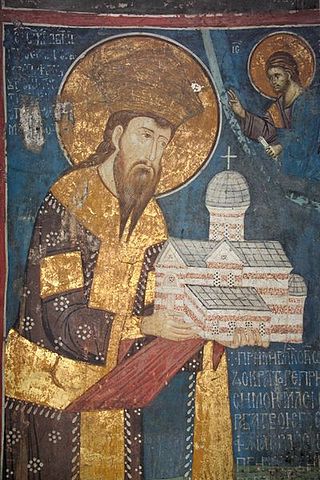Top Qs
Timeline
Chat
Perspective
Nemanjić dynasty
Serbian medieval dynasty From Wikipedia, the free encyclopedia
Remove ads
The House of Nemanjić (Serbian Cyrillic: Немањић, pl. Немањићи; Serbian Latin: Nemanjić, pl. Nemanjići, pronounced [nɛ̌maɲitɕ]) was the most prominent native Serbian dynasty of Serbia in the Middle Ages. This princely, royal and imperial house produced twelve Serbian monarchs, who ruled between 1166 and 1371.[1]
Its progenitor was Stefan Nemanja, scion of a cadet branch of the Vukanović dynasty (1101–1166). After Nemanja, all monarchs used Stefan as a personal name, or a ruler's name, a tradition adopted for the royal pretensions.[A] The monarchs began as Grand Princes, and with the crowning of Stefan Nemanjić in 1217, the realm was promoted to a Kingdom, and the Serbian Orthodox Church was established in 1219. In 1346, Stefan Dušan was crowned Emperor of the Serbs and Greeks, and the Archbishopric of Serbia was elevated to a Patriarchate.[2]
The dynasty's rule in Serbia ended in 1371, with the death of childless Stefan Uroš V (r. 1355–1371).[3] This led to the fall of the Serbian Empire. Provincial lords took control of their provinces. The last remaining members of the House of Nemanjić were John Uroš,[4] ruler of Thessaly, titular emperor of the Serbians and Greeks, who died c. 1422-23, and his younger brother, Stefan Uroš, ruler of Pharsalos. Nemanjić descent survived only through maternal lines in several Serbian houses.[5]
Remove ads
Background


In the 8th century, the Vlastimirović Dynasty established the Serbian Principality.[6] The state disintegrated after the death of the last known Vlastimirid ruler Časlav of Serbia around 940/960s and the Byzantines annexed the region and held it for a century, until 1040 when the Serbs under the Vojislavljević Dynasty revolted in Duklja (Pomorje).[7] In the 1090s, the Vukanović Dynasty established the Serbian Grand Principality, and since the mid-12th century Stari Ras became undisputably under Serbian control, becoming centre of defence and residency for the Serbian Principality.[8][9] In 1166, Stefan Nemanja took the throne, marking the beginning of Serbia, henceforth under the rule of the Nemanjići (Vukanović branch).[10]
Remove ads
Serbia under the Nemanjić dynasty
Summarize
Perspective

Serbia reached its height of power during the Nemanjić dynasty. The Serbian Kingdom was proclaimed in 1217, leading to the establishment of the Serbian Orthodox Church in 1219. In the same year Saint Sava published the first constitution in Serbia: St. Sava's Nomocanon.[11]Tsar Stefan Dušan proclaimed the Serbian Empire in 1346. During Dušan's rule, Serbia reached its territorial, political, and economical peak,[12] proclaiming itself as the successor of the Byzantine Empire, and was the most powerful Balkan state of that time. Dušan enacted an extensive constitution, known as Dušan's Code, opened new trade routes, strengthened the state's economy, but its society's integration was unfinished and not unified enough until Ottoman invasion.[12] Serbian medieval political identity has been profoundly shaped by the rule of this dynasty and its accomplishments, that were supported and cultivated by the Serbian Orthodox Church.[13]
Stefan Dušan attempted to organize a Crusade with the Pope against the threatening Turks,[14] but he died suddenly in December 1355.[15] He was succeeded by his son Uroš, called the Weak, a term that might also apply to the state of the empire, which slowly slid into a feudal fragmentation.[3] This was a period marked by the rise of a new threat: the Ottoman Turk sultanate, which spread from Asia to Europe conquering Byzantium and then the other states in the Balkans.
Remove ads
Members
Summarize
Perspective

Monarchs
The Nemanjić dynasty ruled the Serb lands between ca. 1166 up to 1371.
Remove ads
Monasteries built
The Nemanjić dynasty played a pivotal role in the spread of Eastern Orthodoxy throughout the Balkans. As key patrons of the Serbian Orthodox Church, the Nemanjić rulers were instrumental in the construction and endowment of numerous monastic complexes, thereby reinforcing both religious and cultural identity in medieval Serbia. Their commitment to Orthodoxy significantly contributed to their status as one of the most influential dynasties in Serbian history.
The architectural and cultural legacy of the Nemanjić period is evident in the extensive network of monasteries that continue to serve as vital historical and religious landmarks. Notable examples include Žiča Monastery, Studenica Monastery, Gračanica Monastery, Ljubostinja, Banjska Monastery, Mileševa Monastery, Hilandar Monastery, Đurđevi Stupovi, Sopoćani Monastery, Visoki Dečani Monastery, Gradac Monastery, Morača Monastery, Gorioč Monastery, the Monastery of the Holy Archangels, Matejče Monastery, Our Lady of Ljeviš, Papraća Monastery, Tronoša Monastery, Rača Monastery, Arilje Monastery, Bešenovo Monastery, and Davidovica Monastery, among many others.
Remove ads
Other members
- Đorđe Nemanjić (1208–1243), King (titular) of Zeta
- Stefan Vladislav II, King of Syrmia, (r. 1321–1325)[20]
Family tree
In popular culture
- 1875 historical three-tome novel "Car Dušan" by Dr Vladan Đorđević tells the story of Emperor Dušan.[21]
- 1987 historical novel "Stefan Dušan" by Slavomir Nastasijević is another story of Emperor Dušan.[22]
- 2002 historical novel "Dušan Silni" ("Dušan the Great") by Mile Kordić.[23]
- 2012 novel "Izvori - Roman o Nemanji i Svetom Savi" ("The Wellsprings - The story of Nemanja and Saint Sava") by Milan Miletić depicts Stefan Nemanja and his son, Saint Sava.[24]
- 2015 novel "Gora Preobraženja" by Ljiljana Habjanović Đurović tells the story of Saint Sava.[25]
- 2017 TV series "Nemanjići - rađanje kraljevine" (Nemanjić Dynasty: The Birth Of The Kingdom) portrays the rule of King Stefan the First-Crowned, the first King of Serbia.[26][27]
- https://www.zaduzbine-nemanjica.rs/zaduzbine-nemanjica.htm
Remove ads
Notes
- ^ Name: The name Stefan in Serbian is derived from Greek Stephanos (Στέφανος, tr. Stéphanos), meaning "crown". All the rulers from family Nemanjić had one, or more other names (Nemanja, Uroš, ...) with the common name Stefan. That is the main reason why some Serbian historians write, in recent works, that the name Stefan was not personal, but only a common one, or a ruler's name among the rulers from the Nemanjić family.
Remove ads
See also
Wikimedia Commons has media related to Nemanjić dynasty.
References
Sources
External links
Wikiwand - on
Seamless Wikipedia browsing. On steroids.
Remove ads













